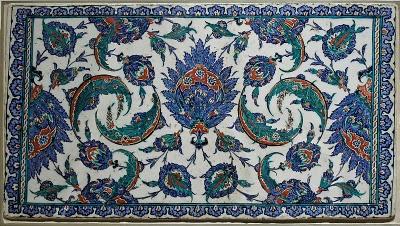
Iznik-Fliesen. Osmanisch, 16. Jahrhundert, heute im Louvre, Paris
Vor kurzem ist ja die ZDF-Dokumentation "Der Heilige Krieg" zu ihrem Abschluss gekommen. Ich hatte hier schon darauf Bezug genommen, ebenso habe ich das Verhältnis der Religionen um das sich diese Doku im Grunde dreht ebenfalls im Blog thematisiert. Schwerpunktmäßig bezogen auf das letzte halbe Jahrtausend osmanischer Herrschaft.
Wer nun einen kürzeren Überblick über das Verhältnis zwischen dem Islam und den anderen Religionen oder anderen Gruppen sucht, der möge sich mal diese Darstellung anschauen, von den Anfängen, bis zur Gegenwart, inklusive des Internets:
Aus: Martin, Richard C. (Hrsg.):Encyclopedia of Islam and the Muslim world. 2004.
ISLAM AND OTHER RELIGIONS
Understanding the relations between Muslims and a variety of religious “Others,” including Jews, Christians, Zoroastrians, Hindus, Buddhists, as well as Africans, Chinese, Mongols, Turks, and Westerners, depends on how one defines religion and religious. In addition, there is a diversity of Muslim identities that shapes the various perceptions of and relations to religious Others, just as there are many identities other than religious ones that intersect with the Muslim-Others duality, such as tribal, ethnic, linguistic, national, and the like. As with any categorization of identities and concepts, the boundaries between Islam and Others remain fluid, and exceptions can often be found. The most striking example of this fluidity is the term umma, which came to mean, from the first centuries of Islam until today, the community of all Muslims in contradistinction to all Others, whether religious or not. Yet, initially, umma included Muslims as well as non-Muslims, and it especially included Jews, as indicated in the so-called Constitution of Medina negotiated by the prophet Muhammad as a basis for the migration of his nascent Islamic community from Mecca to Medina in 622 C.E. The umma referred to then was inclusive of all the peoples living in Medina under the leadership of the prophet Muhammad.
It is nevertheless possible to generalize and say that the history of Muslim-Other relations has been interpreted by Muslims through the lenses of a tripartite theological division of the human world: Muslims, who submit to the will of God as revealed in the Qur'an; People of the Book, who believe in the same God although their knowledge comes from a distorted version of the original divine revelation; and Unbelievers, who either associate idols to God or deny God’s existence. This categorization emerged out of the unique historical context of the lifetime of the prophet Muhammad, (ca. 570–632 C.E.) in central Arabia, and evolved over time, becoming increasingly complex as Islam grew in numbers and in
geographical spread.
Bitte hier weiter lesen:


